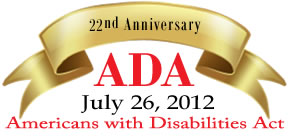July 08, 2012

The ADA was signed into law on July 26, 1990, increasing opportunities experienced by people with disabilities. In the weeks leading up to the July 26th anniversary, groups of people with disabilities, Centers for Independent Living, disability organizations, and State and local governments will be celebrating the full and active participation in community life made possible by the Americans with Disabilities Act.
What is the ADA and ADAAA?
The Americans with Disabilities Act (ADA) of 1990 and the ADA Amendments Act (ADAAA) of 2008 give civil rights protections to individuals with disabilities similar to those provided to individuals on the basis of race, color, sex, national origin, age, and religion.
The ADA and the ADAAA are not affirmative action laws. Instead, they protect Americans with disabilities against acts of discrimination on the basis of their disability. The intent of the ADA and ADAAA is to guarantee that people with disabilities have equal opportunity to access to businesses, employment, transportation, State and local government programs and services, and telecommunications.
The ADA protects over 54 million Americans with disabilities against discrimination on the basis of their disability. Disabilities are defined as physical or mental impairments that substantially limit one or more of their daily activities, such as working, walking, talking, seeing, hearing, or caring for oneself. People who have a record of such an impairment (for example, someone who has had a heart attack or was treated for cancer) and those regarded as having an impairment (whether or not they actually have a disability) are also protected.
For more information and resources about the ADA anniversary, visit our ADA Anniversary page and the ADA Anniversary Toolkit, created by BBI’s Southeast ADA Center and its Leadership Network.